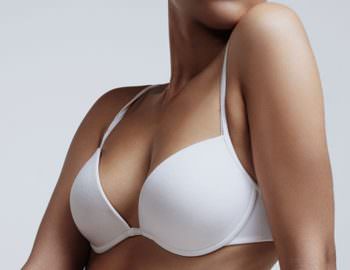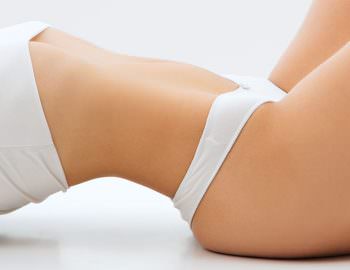
- Periareolar Incision
This half circle incision is typically made at the lower edge of the areola where the areola meets the lighter pigmented breast tissue. The implant is inserted through the incision site into a pocket, which has been created to hold the implant in place. Once inserted, the implant is positioned and centered.
Pros and Cons
Benefits to this incision type include the fact that the surgeon has more control and precision in the placement and positioning of the breast implant due to the direct access provided by the incision location.
Since the incision is in close proximity to the implant location, this allows the surgeon to better control and minimize and bleeding which may occur during the procedure.
ANY ADDITIONAL PROS TO ADD HERE?
Cons include a potential loss of breast/nipple sensitivity and the potential of severing milk ducts and nerves, which can impede breastfeeding postoperatively. In addition, recent scientific data reports that this method is related to the highest rate of capsular contracture. Capsular contracture is the formation of scar tissue around the breast implant resulting in hardening of the tissue surrounding the implant. This can result in changes in the way the breast looks and feels in addition to causing discomfort due to the tightening of tissue surrounding the implant.
IN MY RESEARCH I CAME ACROSS SOME INFORMATION SAYING THAT THIS METHOD CAN TRANSFER BACTERIA BECAUSE THE IMPLANT TRAVELS THROUGH THE SKIN AND SEVERAL BARRIERS BEFORE BEING PLACED IN THE BREAST POCKET. I DIDN’T THINK IT WAS NECESSARY TO INCLUDE HERE, BUT IF YOU WOULD LIKE TO ADD IT, JUST LET ME KNOW AND I WILL PUT IT IN WITH THE POTENTIAL CONS. I DIDN’T FEEL LIKE IT ADDED MUCH IN TERMS OF SUBSTANCE AND I COULDN’T FIND ANY DIRECT SIDE EFFECTS LIKE AN INCREASED RISK OF INFENCTION DUE TO THE BACTERIA.
Scarring
Scarring with the periareolar incision typically fades over time and is often well hidden due to the difference in skin color and texture at the juncture of areolar and breast tissue. However, at a direct view, scarring can be visible. In some cases where the incision does not heal well, there is a more pronounced scar that can be different in texture and color than the areola.
3: Inframammary Incision
Here the incision is made underneath the fold of the breasts where the lower portion of the breast meets the chest wall. This incision method is often chosen in order to minimize visible scarring and allows for direct access to the breast tissue and implant insertion site.
Pros and Cons
Like the periareolar incision, the inframammary incision allows for the surgeon to have better control over bleeding due to the location of the incision. The incision site can also be used for future surgeries, which reduces the number of potential scars in the event future surgeries are required. This incision type is often chosen because a bra, bikini, or the breast itself easily hides it, if the breast naturally hangs slightly over the incision site.
One potential downside to the inframammary incision is that the scarring location impedes or makes it difficult to change breast size in the future. This is due to the fact that the scar would move up in the event that a patient was to switch to a larger implant. Conversely, the scar would move down if the patient decided to decrease the size of her implants or remove them altogether at some point in the future. Finally, it may be more difficult for the surgeon to precisely position this type of incision in patients with smaller breasts to begin with or those with minimal natural creasing at the breast to chest juncture prior to augmentation.
Scarring
Larger breasts that hang over the incision site more easily hide scarring. However, with smaller implants or in cases where a natural crease does not form between the breast and the chest wall, scarring from the inframammary incision may be visible and more prominent.
- Transaxillary Incision
The transaxillary incision is made at the crease of the armpit, and breast augmentation using this site can be done both endosopically and using a traditional open approach. (PLEASE ADVISE IF YOU WANT TO GO INTO FURTHER DETAIL ABOUT ENDOSCOPIC HERE) This approach is more technically demanding and requires a high level of surgical expertise, since the incision is not made directly on the breast. Once the incision is made, a path to the breast is created and a pocket is made where the implant will be placed. Both saline and silicone implants can be used with this incision type. However, saline is generally preferred since the implant can be inserted empty and filled once it has been placed inside the breast pocket, thus keeping the size of the incision as small as possible.
Pros and cons
The transaxillary incision scar typically heals and often disappears for most patients, which tends to make this method popular. In addition, this incision type is further away from the breast and leaves the surface of the external breast and chest tissue surgically untouched. This method is least likely to damage mammary glands, therefore making this incision type desirable for women who plan to get pregnant and breastfeed in the future.
Perhaps the largest drawback of the transaxillary incision is that the site cannot be used again in the event of future breast surgeries. Finally, due to the location of the incision, there is a possibility for a loss of sensation in the armpit or hand/arm in the event that nerves are severed or damaged during the procedure.
Scarring
As discussed, this method is popular due to the lack of visible scarring on or around the breasts. Since the incision is made at the natural fold of the armpit, scarring is minimal and often disappears completely in most patients. In some patients, however, visible scarring can remain and be seen with some clothes, depending on the cut of the sleeve or clothing item being worn.
Post-Op Expectations
The speed of recovery and healing of sutures can vary depending on the individual, but patients are generally advised to rest for three to five days following a breast augmentation procedure. This allows the body to recover from anesthesia and for the management of any postoperative pain. Immediately following the procedure, the implants are likely to be positioned high on the chest wall. This is normal, and over the course of the next three months, the implants will settle and become softer and easier to move.
Patients are advised to avoid any sort of heavy lifting for four to six weeks. During this time, soreness and swelling is expected, but will improve over time. Patients can generally resume their regular activity, including strength training and weight lifting four to six weeks after surgery, but this should be done under the discretion of the surgeon and the individual recovery of the patient.
Finally, some patients experience numbness or hypersensitivity on or around the nipple after surgery. This is normal and should subside in 3-6 months. (NOT SURE WHERE TO MOVE THIS, SINCE IT DOESN’T REALLY FIT HERE AND DOES NOT FLOW IF INCLUDED IN THE TWO PARAGRAPHS BEFORE)
Post-Op Care
Proper post-operative care is essential and will increase the likelihood of proper healing and a desirable outcome. The most important aspect of post-op care is to be sure to keep all postoperative appointments. Recovery speed and progress depends on the individual patient and the personalized advice of Dr. Totonchi, who closely monitors his patients in order to optimize healing.
Patients are generally advised to rest for three to five days following breast augmentation in order to allow the body to rest and heal from surgery. During this time, it is normal to experience fatigue and some drowsiness due to pain medication and the effects of anesthesia. Patients can begin light walking as tolerated immediately following surgery, but it is important to take things slow and listen to your body and what you are comfortable with doing.
Dr. Totonchi will provide a surgical bra, which is to be worn for approximately 2-4 weeks following surgery. Patients are advised not to purchase any new bras until about 3 months after surgery, when sizing will be most accurate and the implants will have settled and swelling has subsided.
Patients should avoid direct sun exposure to the breasts and surgical area for at least one month postoperatively, and to avoid sun on scar/incision site for up to a year after surgery. It is important to use sunscreen on the scar and to avoid sun exposure, especially the risk of sunburn, which can make darken scars and cause them to appear more prominently.
Finally, patients are advised against submerging in water for at least 3 weeks post operatively. This includes baths, and swimming in the ocean or pool.
Long term care
In addition to short-term postoperative care, breast implants require additional long-term care, which begins with regular postoperative breast examinations in order to evaluate the condition of the implants. While implants can last a lifetime, manufacturers of the implants do not label them to be “lifetime devices”. This means that implants can require being replaced due to deflation, rupture, or other reasons related to patient preference. Notable fluctuations in breast size due to pregnancy, menopause, or weight loss can result in the altered appearance of augmented breasts over the course of time. This change alone may be enough for some women to consider changing the size or shape of their implants.
Complications
As with any surgical procedure there are inherent risks involved with breast augmentation, and it
is important to discuss these risks and ask your surgeon any questions you may have during the consultation process to insure that you are comfortable.
Some risks are common to all surgeries, such as those related to anesthesia, bleeding, infection, pain, and the possibility of revisional surgery being required at some point in the future. Other risks, however, are unique to breast augmentation/ lift procedures. These include changes in nipple and/or breast sensitivity, the formation of tight scar tissue around the implant itself, rippling or wrinkling of the skin, wrong/incorrect placement of implant, implant rupture or leakage, poor scarring, and/or fluid accumulation.
Candidates For Breast Augmentation and Breast Lift
You may be a candidate for Breast Augmentation if your breasts are fully developed (you over the age of 18) and you experience one or more of the following:
- you feel your breasts are asymmetrical
- your breasts lack desired fullness/volume
- you are dissatisfied with the size and/or shape of breasts
- breast shape/volume has decreased significantly due to weight loss, pregnancy, nursing, aging, etc
- one or both breasts has not fully developed normally
Women electing to undergo a breast lift either on its own or in conjunction with breast augmentation wish to restore a more youthful breast profile. This is accomplished removing excess sagging breast tissue and raising breasts higher onto the chest.
Implant types
Dr. Totonchi offers both saline and silicone implants to his patients. Both types of implant have an outer shell made of silicone. The difference is in the material used to fill the breast implant. Saline implants are filled with sterile salt water by the surgeon at the time of surgery, which allows more surgeon control when it comes to implant volume. In the event of rupture, the saline solution will leak and deflate, causing the breast to change shape and size. There is no health risk associated with the body’s absorption of the saline solution; however, surgery will be required to remove the shell of the implant. At that time, a new implant can be inserted.
Silocone implants come pre-filled with a silicone gel and arrive sealed by the manufacturer. The silicone gel is a viscous material that is purported by many women to look and feel more natural, since the gel mimics the look and feel of fat, which breasts are comprised of naturally. In the event rupture, the body does not absorb any silicone that is leaked from the implant. Instead, the gel becomes trapped in the tissue surrounding the implant. This can cause pain or discomfort in addition to possibly changing the shape and/or size of the breast. Oftentimes the rupture of a silicone implant can go undetected by the patient, which is why MRI scans are used to monitor the condition of silicone implants postoperatively. It is recommended that ruptured implants are replaced in order to avoid any complications.



















